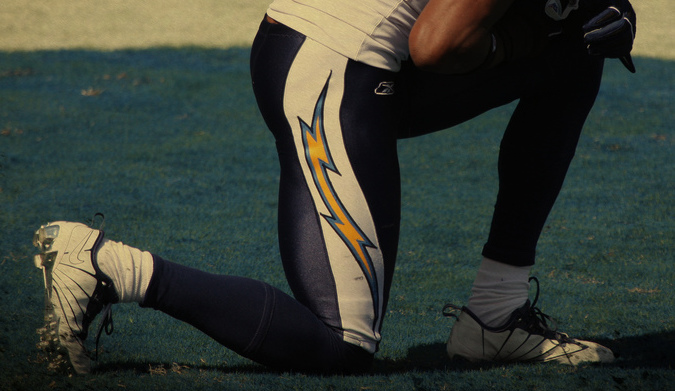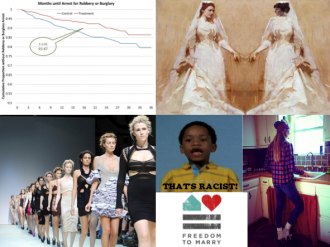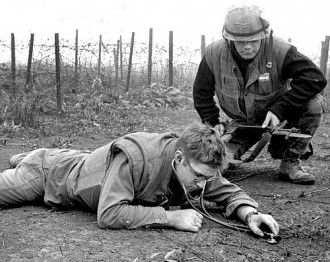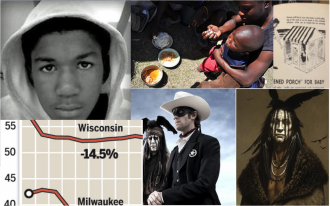
In case you were otherwise occupied, on Christmas Day the Associated Press named the “NFL National Anthem Protests” the top sports story of 2017. In a year of many huge sport stories both on and off the field, the AP said the story was the “runaway winner” for its staff. This doesn’t surprise me at all. I’ve studied sports-based social activism for a long time, but I’ve never had more media calls and requests for interviews in my career than these past few months.
The single biggest reason for the story, I’m pretty sure, involves our President’s seemingly unprompted and unusually profane attacks in September on football players who had engaged in demonstrations and the NFL. For better or for worse, Trump’s attention provoked a tidal wave of unprecedented gestures of protest and support across the league (and across both racial lines as well as those of management and ownerships) that gave the story its scale, scope, and intrigue. But there’s much more to say about it than that, much more. I’ve been tracking this all fall as part of my own research project on the “new era” of African American athletic activism we are currently witnessing, and I am going to pull some of that together in a commentary with my sport and politics collaborator Kyle Green. We are hoping to run that piece in the lead-up to the Super Bowl here in the Twin Cities at the end of January, so stay tuned!
There are two points I’d like to address here, by way of year-end retrospective: “kneeling” and “remembrance.” On kneeling, why do athletes feel the need to protest?
“Why do they do it?” is far and away the most common question I get from journalists and regular folks alike. Underlying this inquiry is the sense (a) that these demonstrations are disrespectful and (b) that professional athletes are super-rich, superstars who should be so satisfied with their lives and salaries and fame that they’d have no reason to complain or be angry, much less act out in public. At best, they see African American athlete activists as spoiled complainers, more interested in politics, making news, and making money than anything else. For many Americans, athletic protests are as incomprehensible as they are inappropriate.
Based on the athletes I’ve talked to and my earlier research on black athletic activism in the 1960s, I see the issue quite differently. and commitments. In a society that continues to be plagued by disproportionate police brutality, persistent racial gaps, and overt bigotry and bias, they feel compelled to do or say something. Sometimes it is in support of communities of color—their communities—who continue to face persistent racism and discrimination. Sometimes it is quite personal, stemming from their own ongoing individual experiences with racism and discrimination. And almost always it is quite principled and reasoned, with a clear understanding of the costs and consequences (which are far more real and extensive than most of us realize). Athlete activists don’t take their activities lightly or think of them as disrespectful or anti-American. Quite the contrary, they understand activism as consistent with the higher moral standards, ideals, and aspirations of both American democracy and sport culture.
But there is something else here too: It is also the fact that many —to make it seem like everything is okay. This was a major motivator for the African American athletes who participated in protests in the year leading up to the 1968 Olympic Games. As high jumper Gene Johnson explained in support of the “Olympic Project for Human Rights:”
“The United States exalts its Olympic star athletes as representatives of a democratic and free society, when millions of Negro and other minority citizens are excluded from decent housing and meaningful employment” (Race, Culture, and the Revolt, 2003, p. 84).
Or, as the OPHR organizing pamphlet put it: “We must no longer allow this country to use black individuals of whatever level to rationalize its treatment of the black masses.”
So, that’s kneeling, now for remembrance. A few weeks back I was interviewed by a Time reporter for a special 50th anniversary retrospective issue on the tumultuous year of 1968. Among other things, the reporter asked me what my research on Tommie Smith and John Carlos’s iconic victory stand demonstration taught me about the meanings and implications of the protests of Colin Kaepernick and his NFL brethren. “How will we remember what is going on today, 50 years from now,” she wanted to know?
Social scientists like me, I told her, are loath to make predictions. However this topic is one where I was willing to make an exception. I’m pretty confident that one day in the not-to-distant near future, Kaepernick and company will be remembered far more positively across the American populace than is currently the case. In fact, it wouldn’t surprise me at all if, once the specifics of this moment and the larger racial politics that are unfolding are behind us, these athlete activists come to be revered as courageous, admirable, or even heroic—certainly ahead of their time. If you’re interested, my little quote to this effect can now be found in print on page 92 of the latest issue of Time (dated Dec. 25/Jan. 1) as well as online here.
Such historical re-remembering is a familiar pattern in American culture. It happened to our collective conceptions of Martin Luther King, Jr. and Muhammad Ali. Perhaps most pertinent to this discussion are the memories that surround the perpetrators of one of the most iconic sports demonstrations of all time, Tommie Smith and John Carlos’s 1968 clenched first, victory stand demonstration at the 1968 Mexico City Olympics. Today, most Americans celebrate Smith and Carlos as heroes of the Civil Rights Movement; back in 1968, they were seen as villains, traitors, and worse.
History and memory—what happened and how we think about what happened—are two different things. All too often, the way we remember and romanticize images, individuals, and events comes at the cost of forgetting all of the actual social issues and context that gave rise to them in the first place. As this year draws to a close and we begin to look to the future, let us not lose sight of the racial disparities and social injustices at the root of the biggest sports story of 2017.








